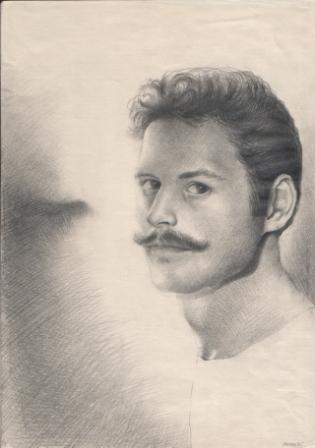
József Olexa
fine-artistJózsef Olexa was born in Budapest in 1960. After completing the Technical School of Printing Technology he was attending the College of Fine Arts. Joined the Hungarian Artists Fund in 1989 and has been a member of the Association of Hungarian Artists and other associations (Altamira, KBK, Art 9) since 1991. Made study tours to Canada, Florida, Arizona, England, Andalusia and Zambia.
Applies various techniques from painting through etching to metal point. Worked as a school teacher in Kispest and Kőbánya and ran the ‘Rembrandt’ graphic workshop in Erzsébetváros for ten years.
Upon commission by district authorities, manufactured deeds and decorative objects to go with honorary citizenship.
Prepared applied graphic and publication designs and illustrations for literary periodicals.
The ecstasy of the promise
When looking at the 24 exhibited pictures of József Olexa we can state with joy and satisfaction that nowadays, when actors have reached the stage of contesting every value which has previously been accepted, when serving gods is succeeded by searching for the demands of the market, and when order is superseded by confusion, young people suddenly emerge seeking a forum where the plain word can be expressed.
The most characteristic and outstanding feature of Olexa’s pictures is their linkage with traditions. He pursued his studies at Imre Kéri’school, where he trained extensively in traditional etching techniques used by generations of craftsmen. He has also learnt that the experience of sight must not be banished unpunished because reality, which consist of a thousand colours and a thousand formations, slips easily through the wide-meshed net of abstraction. Ego – the heart, spirit and attitude of the artist – must be added to this sight. The picture is confessions about the world and confessions about himself and unity.
A creation from this duality guarantees authenticity. Olexa draws the picture of a tree, the basalt organ having many pipes, or the red and yellow coloured flower of burning love with such empathy that the tree, the stone and flower almost appear to have drawn themselves. By associative indications of the pumpkin, the melon and cabbage, by the sensuality of roundish forms and by the rhythm of protuberances and bends, he makes the flora speak and express human desires. If we look at his landscape drawn at nights – hills, forests, stars, the vibrations of light glimmering through the trees, the celestial world being reflected on the blades of grass of the velvety black nights, or the surrealist vision of the rearing night bear seeking for his den – we can notice the additional value which is born in the tension of silence and we almost seem to hear the music of the night, enchanting and ecstasizing, with a potential of a thousands watts; the same way Béla Bartók used to hear it. This music however, is not only the music of joy, but the valediction of former unhurt beauty, the crying of the trees burnt by acid rain , the scream of life condemned to death. He works consistently with drive; he is one of those people who – in our darkening days – are listening to the senses, to the heart and to the inspirations coming from behind the stars.
He is one who wants to see values displayed prominently in their original places; he turns to the lot and sufferings of this fellow – creatures with heartfelt sympathies.
The drawings of Olexa promise us the way out and future in present time of contesting values.
Some public and private collections containing works of art by József Olexa:
- National Agricultural Library and Documentation Centre
- Old people’s home, Wekerle estate
- Mayor’s office, Kispest
- National Memorial Committee
- Museum of Applied Arts, Budapest
- Community Arts Centre, Szentes
- Community Arts Centre, Ajka
- Environmental Protection Centre, Somogy County

